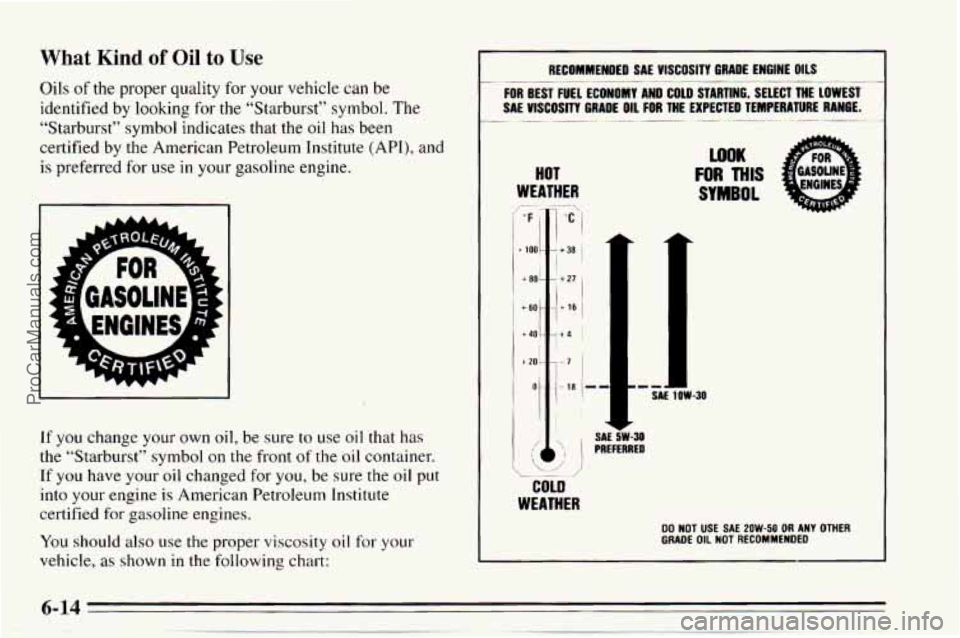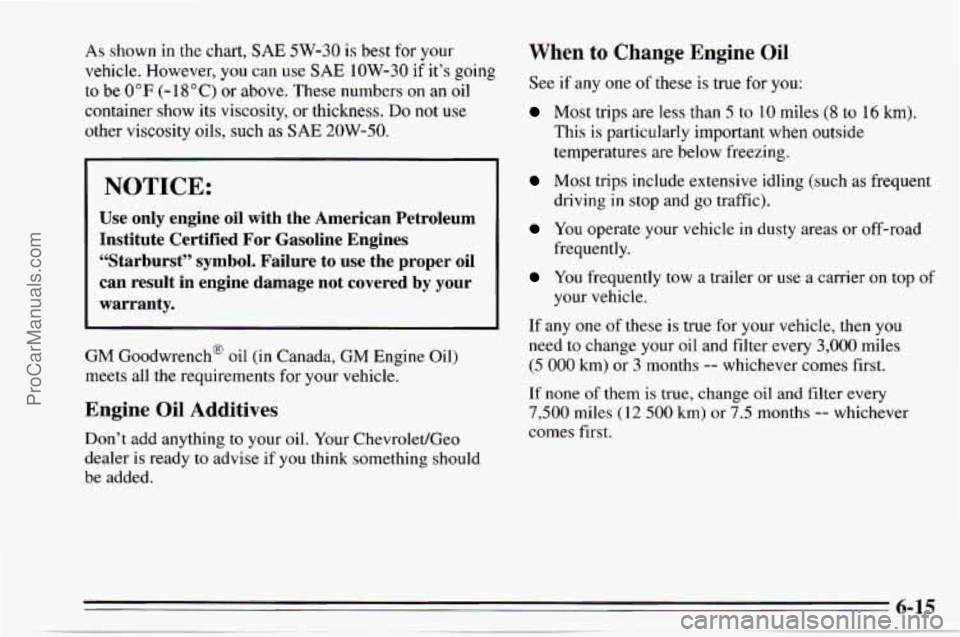1995 CHEVROLET TRACKER oil temperature
[x] Cancel search: oil temperaturePage 225 of 354

What Kind of Oil to Use
Oils of the proper quality for your vehicle can be
identified by looking
for the “Starburst” symbol. The
“Starburst” symbol indicates that the oil has been
certified by the American Petroleum Institute
(API), and
is preferred for use
in your gasoline engine.
If you change your own oil, be sure to use oil that has
the “Starburst” symbol on the front of the oil container.
If you have your oil changed for you, be sure the oil put
into
your engine is American Petroleum Institute
certified
for gasoline engines.
You should also use the proper viscosity oil for your
vehicle,
as shown in the following chart:
RECOMMENDED SAE VISCOSITY GRADE ENGINE OILS
FOR BEST FUEL ECONOMY AND COLD STARTING, SELECT THE LOWEST
SAE VISCOSITY GRADE OIL FOR THE EXPECTED TEMPERATURE RANGE. __ ~ ~ .~
HOT
WEATHER --
+ 80
+ 60
t 20
-. -. ./ \.. ~ ,.,’ ,
COLD
WEATHER
LOOK
FOR THIS
SYMBOL
SAE ZW-30 PREFERRED
DO NOT USE SAE 2OW-50 OR ANY OTHER
GRADE OIL NOT RECOMMENDED
6-14
ProCarManuals.com
Page 226 of 354

As shown in the chart, SAE 5W-30 is best for your
vehicle. However, you can use
SAE 10W-30 if it's going
to be 0°F (-18°C) or above. These numbers on an oil
container show its viscosity, or thickness.
Do not use
other viscosity oils, such
as SAE 20W-50.
NOTICE:
Use only engine oil with the American Petroleum
Institute Certified For Gasoline Engines
"Starburst" symbol. Failure to use the proper oil
can result in engine damage not covered by your
warranty.
GM Goodwrench@ oil (in Canada, GM Engine Oil)
meets all the requirements for your vehicle.
Engine Oil Additives
Don't add anything to your oil. Your Chevrolet/Geo
dealer is ready to advise if you think something should
be added.
When to Change Engine Oil
See if any one of these is true for you:
Most trips are less than 5 to 10 miles (8 to 16 krn).
This
is particularly important when outside
temperatures are below freezing.
driving in stop and
go traffic).
Most trips include extensive idling (such as frequent
You operate your vehicle in dusty areas or off-road
You frequently tow a trailer or use a carrier on top of
frequently.
your vehicle.
If any one
of these is true for your vehicle, then you
need to change your oil and filter every 3,000 miles
(5 000 km) or 3 months -- whichever comes first.
If none of them is true, change oil and filter every
7,500 miles (12 500 km) or 7.5 months -- whichever
comes first.
ProCarManuals.com
Page 230 of 354

Automatic Transmission Fluid
When to Check and Change
A good time to check your automatic transmission fluid
level is when the engine oil is changed. Refer to the
Maintenance Schedule to determine
when to change
your fluid. See “Scheduled Maintenance Services”
in the
Index.
How to Check
Because this operation can be a little difficult, you may
choose to have this done at your Chevrolet/Geo dealer
Service Department.
If you do it yourself, be sure to follow all the
instructions here, or you could get a false reading on the
dipstick.
NOTICE:
Too much or too little fluid can damage your
transmission.
Too much can mean that some of
the fluid could come out and fall on hot engine
parts or exhaust system parts, starting a fire. Be sure to get an accurate reading if you check your
transmission fluid.
Wait at least 30 minutes before checking the
transmission fluid level if you have been driving:
0 When outside temperatures are above 90°F (32°C).
At high speed for quite a while.
0 In heavy traffic -- especially in hot weather.
0 While pulling a trailer.
To get the right reading, the fluid should be at normal
operating temperature, which is
180” F to 200” F
(82°C to 93°C).
ProCarManuals.com
Page 236 of 354

Front Axle Engine Coolant
When to Check and Change Lubricant
Refer to the Maintenance Schedule to determine how
often to check the lubricant and when to change it. See
“Periodic Maintenance Inspections” and “Scheduled
Maintenance Services” in the Index.
How to Check Lubricant
If the level is below the bottom of the filler plug hole,
you’ll need to add some lubricant.
If the differential is at operating temperature (warm),
add enough lubricant to raise the level to the bottom of
the filler plug hole.
If the differential is cold, add enough lubricant to raise
the level to 1/2 inch (12 mm) below the filler plug hole.
What to Use
Refer to the Maintenance Schedule to determine what
kind of lubricant to use. See “Recommended Fluids and
Lubricants” in the Index. The following explains
your cooling
system and how to
add coolant when it is low. If you have a problem with
engine overheating, see “Engine Overheating’’ in the
Index.
The proper coolant for your Geo will:
0 Give freezing protection down to -33°F (-36°C).
Give boiling protection up to 258°F (125°C).
Protect against rust and corrosion.
Help keep the proper engine temperature.
Let the warning lights work as they should.
What to Use
Use a mixture of one-half clean water (preferably
distilled) and one-half antifreeze that meets
“GM
Specification 1825M,” which won’t damage aluminum
parts. You can also use a recycled coolant conforming to
GM Specification 1825M with a complete coolant flush
and refill. If you use this mixture, you don’t need to add
anything else.
ProCarManuals.com
Page 281 of 354

Maintenance Schedule
I Schedule I Definition
Follow Maintenance Schedule I if any one of these is
true for your vehicle:
Most trips are less than 5 to 10 miles (8 to 16 km).
This is particularly important when outside
temperatures are below freezing.
driving
in stop-and-go traffic).
Most trips include extensive idling (such as frequent
0 You frequently tow a trailer or use a carrier on top of
your vehicle.
Schedule
I should also be followed if the vehicle is used
for delivery service, police, taxi, or other commercial
application.
Schedule I Intervals
Every 3,000 Miles (5 000 km) or 3 Months,
Whichever Occurs First
Engine Oil and Filter Change
Free-Wheeling Hubs Inspection (If Equipped)
Every 6,000 Miles (10 000 km) or 6 Months,
Whichever Occurs First
Tire Rotation
Every 15,000 Miles (25 000 km)
Air Cleaner Filter Inspection, if driving in dusty
Front Wheel Bearing Repack (or at each brake
Manual Transmission Fluid Change (or every
Engine Idle Speed Check
Valve Lash (Clearance) Adjustment
Propeller Shafts and U-Joints Inspection (or every conditions
relining, whichever occurs first)
15 months, whichever occurs first)
15 months, whichever occurs first)
ProCarManuals.com
Page 347 of 354

Easy-Entry Seat ................................ I -4
Electrical Equipment. Adding
................ 2-10. 6-59
Enginecoolant
................................. 6-25
Adding
.................................... 6-26
Checking
................................... 6-26
Temperature Gage
............................ 2-46
Exhaust
.................................... 2-25
Identification
................................ 6-59
Overheating
................................. 5- 1 1
Running it While You’re Parked ................. 2-25
Specifications
............................... 6-64
Starting
..................................... 2-9
16-Valve
................................... 6-10
8-Valve
..................................... 6-8
Engineoil
.................................... 6-12
Adding
.................................... 6-13
Additives
................................... 6-15
Checking ................................... 6-12
Pressure Light
............................... 2-47
What Kind to Use
............................ 6- 14
What to do with Used Oil
...................... 6- I6
Whentochange
............................. 6-15
Ethanol(InFue1)
................................ 6-3
Exhaust. Engine
................................ 2-25
Expectant Mothers. Use
of Safety Belts ............. 1-20
Extender. Safety Belt ............................ 1-34
Fabric Cleaning
............................... 6-50
Fan Control Lever ............................... 3-2
Feature. Theft-Deterrent
.................... 3- 10. 3- 15
Fifth (5). Manual Transmission .................... 2- 15
FillingYourTank ................................ 6-4
Engine
Filter. Air Cleaner
.............................. 6-18
Finish Care
.................................... 6-54
Finish Damage
................................. 6-56
First
(1). Manual Transmission .................... 2-14
Flashers. Hazard Warning
......................... 5-1
Flat Tire. Changing
............................. 5-21
Flow-Through Ventilation System
................... 3-4
Fluid Capacities Chart ........................... 6-65
Flushing. Underbody
............................ 7-51
Folding Rear Seat
................................ 1-5
Foreign Countries. Fuel
........................... 6-4
Four-wheel Drive
......................... 2-17. 6-24
Fourth (4). Manual Transmission
................... 2-15
Freewheeling
Hubs ............................. 2-17
FrenchLanguage Manual
11
Front Ashtray .................................. 2-36
FrontAxle
.................................... 6-25
Front Parking and Turn Signal. Replacement
......... 6-37
Front Seat Side Pockets
........................... 2-6
Front Towing Hook-Ups
.......................... 5-8
Fuel
.......................................... 6-2
Gage
...................................... 2-48
Fuse Block. Instrument Panel
..................... 6-42
Fuse Block. Main
............................... 6-62
Fuseusage
.................................... 6-62
Fuses and Circuit Breakers
....................... 6-60
Gage
.. ...........................
FillingYourTank ............................. 6-4
In Foreign Countries
........................... 6-4
Engine Coolant Temperature
................... 2-46
Fuel
....................................... 2-48
Gasolines for Cleaner Air
......................... 6-3
9-4
-.-- .- _____ ..... .... --.-_Y_I____N___W___l~~=,,ll--C. ~~ ~ ProCarManuals.com
Page 349 of 354

Temperature Control ........................... 3-2
Brake System Warning
........................ 2-45
Charging System
............................. 2-44
Check Engine
............................... 2-46
Engine Oil Pressure
.......................... 2-47
Safety Belt Reminder
..................... 1-9. 2-44
Lighter. Cigarette
............................... 2-36
Loading Your Vehicle
........................... 4-42
Lights
Daytime Running Lamps
(DRL) Indicator ......... 2-49
Loading Your Vehicle
for Off-Road Driving .......... 4-14
Locks Door
....................................... 2-2
Steering Column
............................. 7-50
Tailgate
..................................... 2-4
Torque
..................................... 2-22
Long Trip. Before Leaving on a
.................... 4-33
Loss of Control
................................ 4-12
Low
(L) Position. Automatic Transmission ........... 2- 14
Lowering and Raising the Canvas Top
.............. 2-56
Lubrication. Body
.............................. 7-49
Main Fuse Block
.............................. 6-62
Maintenance Record
............................ 7-56
Maintenance Schedule
............................ 7- 1
Owner Checks and Services .................... 7-48
Periodic Maintenance Inspections
............... 7-52
Recommended Fluids and Lubricants
............ 7-54
Schedule1
................................... 7-8
Schedule
I Definition .......................... 7-4
ScheduleII
................................. 7-33
Schedule
11 Definition .......................... 7-6 Scheduled Maintenance Services
................. 7-2
Maintenance. Underbody
......................... 6-57
Maintenance. When Trailer Towing
................. 4-51
Malfunction Indicator Lamp (Check Engine Light)
.... 2-46
Manual Front Seat
............................... 1-1
Manual Remote Control Mirror Manual Transmission
............................ 2-14
Fifth (5) Position
............................. 2-15
First (1) Position
............................. 2-14
Fourth (4) Position
........................... 2-15
Neutral
(N) Position .......................... 2-15
Parking Your Vehicle
......................... 2-24
Reverse (R) Position
.......................... 2-15
Second
(2) Position ........................... 2-15
Shiftspeeds
................................ 2-16
Starting Your Engine
........................... 2-9
Third (3) Position
............................ 2-15
Manual Transmission Fluid
....................... 6-22
Adding
.................................... 6-23
Checking
................................... 6-22
ManualWindows
............................... 2-26
Methanol (In
Fuel) ............................... 6-3
Mirrors
....................................... 2-34
Convex Outside
............................. 2-35
Inside Rearview
............................. 2-34
Outside Manual Adjust
........................ 2-34
MTBE (In Fuel)
................................. 6-3
Neutral
(N) Position, Automatic Transmission ....... 2-13
Neutral (N) Position, Manual Transmission
.......... 2-15
New Vehicle “Break-In”
.......................... 2-7
Nightvision
................................... 4-27
9-6
ProCarManuals.com